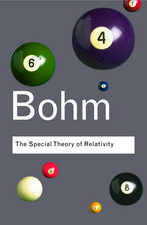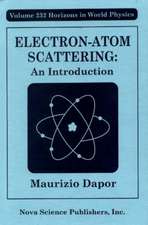Theoretical Nuclear Physics
Autor J. M. Blatt, V. F. Weisskopfen Limba Engleză Paperback – 17 noi 2011
Preț: 821.47 lei
Preț vechi: 1026.84 lei
-20% Nou
Puncte Express: 1232
Preț estimativ în valută:
157.21€ • 163.52$ • 129.78£
157.21€ • 163.52$ • 129.78£
Carte disponibilă
Livrare economică 24 martie-07 aprilie
Livrare express 08-14 martie pentru 54.86 lei
Preluare comenzi: 021 569.72.76
Specificații
ISBN-13: 9781461299615
ISBN-10: 1461299616
Pagini: 884
Ilustrații: XIV, 864 p.
Dimensiuni: 152 x 229 x 50 mm
Greutate: 1.16 kg
Ediția:Softcover reprint of the original 1st ed. 1979
Editura: Springer
Colecția Springer
Locul publicării:New York, NY, United States
ISBN-10: 1461299616
Pagini: 884
Ilustrații: XIV, 864 p.
Dimensiuni: 152 x 229 x 50 mm
Greutate: 1.16 kg
Ediția:Softcover reprint of the original 1st ed. 1979
Editura: Springer
Colecția Springer
Locul publicării:New York, NY, United States
Public țintă
ResearchDescriere
The last twenty years have witnessed an enormous development of nuclear physics. A large number of data have accumulated and many experimental facts are known. As the experimental techniques have achieved greater and greater perfection, the theoretical analysis and interpretation of these data have become correspondingly more accurate and detailed. The development of nuclear physics has depended on the development of physics as a whole. While there were interesting speculations about nuclear constitution as early as 1922, it was impossible to make any quantitative theory of even the simplest nucleus until the discovery of quantum mechanics on the one hand, and the development of experimental methods sufficiently sensitive to detect the presence of a neutral particle (the neutron) on the other hand. The further development of our understanding of the nucleus has depended, and still depends, on the development of ever more powerful experimental techniques for measuring nuclear properties and more powerful theoretical techniques for correlating these properties. Practically every "simple," "reasonable," and "plausible" assumption made in theoretical nuclear physics has turned out to be in need of refinement; and the numerous attempts to derive nuclear forces and the properties of nuclei from a more" fundamental" approach than the analysis of the data have proved unsuccessful so far. Nuclear physics is by no means a finished edifice.
Cuprins
I. General Properties of the Nucleus.- 1. Introduction.- 2. Quantum States, Binding Energy, Binding Fraction.- 3. Stable and Unstable Nuclei, Fission, Alpha-Decay, Beta-Decay.- A. “Dynamical” Instability.- B. Beta-Radioactivity.- 4. Size of the Nuclei.- A. Scattering of High-Energy Neutrons by Nuclei.- B. The Yield of Nuclear Reactions Initiated by Protons or Alpha-Particles.- C. Alpha-Decay Lifetimes.- D. Maximum Energy of Some Beta-Rays.- 5. The Coulomb Barrier.- 6. Angular Momentum, Spin.- 7. Electric and Magnetic Moments.- A. Electric Moments.- B. Magnetic Moments.- 8. Statistics.- Symbols.- II. TWO-BODY PROBLEMS AT LOW ENERGIES.- 1. Introduction.- 2. The Ground State of the Deuteron; Simplified Discussion (Central Forces Assumed).- 3. Neutron-Proton Scattering.- A. Simple Theory.- B. Comparison with Experiment: The Spin Dependence of Nuclear Forces.- C. The Effect of Chemical Binding.- D. Coherent Scattering of Neutrons by Protons.- 4. Proton-Proton Scattering.- 5. The Tensor Force.- A. Experimental Discovery of the Existence of Non-central Forces.- B. General Form of the Non-central Force.- C. Properties of the Tensor Force.- D. The Ground State of the Deuteron: Dynamics.- E. The Ground State of the Deuteron: Quadrupole Moment.- F. The Ground State of the Deuteron: Magnetic Moment.- G. Neutron-Proton Scattering below 10 Mev.- Symbols.- III. Nuclear Forces.- 1. Introduction.- 2. Stability of a nucleus against Collapse. The Impossibility of Attractive Forces between All Pairs.- 3. Exchange Forces.- A. Qualitative Considerations.- B. Formal Definition of Exchange Forces.- 4. The Saturation Conditions.- A. The Comparison Theorem.- B. Saturation Conditions for Mixed Wigner and Majorana Forces.- C. The Complete Saturation Conditions for Central Forces.- D. Saturation Conditions for Tensor Forces.- 5. The Isotopic Spin Formalism.- Symbols.- IV. Two-Body Problems at High Energies.- 1. Introduction.- 2. Neutron-Proton Scattering at Energies between 10 and 30 Mev.- 3. Neutron-Proton Scattering at Energies Larger than 30 Mev.- 4. Proton-Proton Scattering.- Symbols.- V. Three- and Four-Body Problems.- 1. Introduction.- 2. The Ground State of the Triton; Central Forces.- 3. The Ground State of the Alpha-Particle; Central Forces.- 4. H3 and He3: The Equality of Neutron-Neutron and Proton-Proton Forces.- 5. The Ground State of the Triton; Tensor Forces.- Symbols.- VI. Nuclear Spectroscopy: I. General Theory.- 1. The Systematics of Stable Nucle.- A. Stability Conditions.- B. Discussion of Stable Nuclei.- 2. The Semi-Empirical Mass Formula of Weizsäcker.- 3. Detailed Study of the Symmetry Effect.- 4. The Symmetry Energy and the Systematics of Stable Nuclei.- 5. Nuclear Magnetic Moments in Light Elements.- 6. The Spectroscopic Classification of Nuclear Energy Levels.- Symbols.- VII. Nuclear Spectroscopy: II. Special Models.- 1. Introduction.- 2. The Uniform Model of Wigner.- A. Theory.- B. Comparison with Experiment.- 3. The Independent-Particle Model.- A. Introduction.- B. The P Shell Configurations.- C. The Energy of the Ground State.- D. Nuclear Magnetic Moments on the Independent-Particle Model.- E. Criticism of the Independent-Particle Model.- 4. The Alpha-Particle Model of the Nucleus.- A. Outline of the Theory.- B. Criticism of the Alpha-Particle Model.- 5. The Liquid Drop Model.- Symbols.- VIII. Nuclear Reactions: General Theory.- 1. Introduction.- A. Description of a Nuclear Reaction.- B. Channels.- C. Energy Relations.- 2. Cross Sections.- A. Geometrical Limitations on Reaction and Scattering Cross Sections.- B. The Determination of Cross Sections from the Conditions at the Nuclear Surface, for Neutrons with l=0.- C. The Determination of Cross Sections from the Conditions at the Nuclear Surface. General Case.- D. The Angular Distribution of Elastically Scattered Particles.- E. The Reciprocity Theorem for Nuclear Reactions.- 3. The Compound Nucleus, Continuum Theory.- A. The Bohr Assumption.- B. Nuclear Reactions, Cross Sections, and Emission Rates.- 4. Determination of Cross Sections, Continuum Theory.- 5. Transmission of Potential Barriers.- 6. The Decay of the Compound Nucleus.- A. Competition; Evaporation Model.- B. Secondary Nuclear Reactions.- 7. Resonance Theory; Qualitative Treatment.- A. The Occurrence of Resonances.- B. The Compound Nucleus, Level Widths, Qualitative Description.- C. Interpretation of D and ?.- D. Cross Sections for Nuclear Reactions.- E. Behavior of Nuclear Cross Sections near Threshold.- 8. Resonance Theory; Determination of Cross Sections.- A. Pure Resonance Scattering.- B. Resonance Scattering and Resonance Reactions.- 9. Resonance Theory; Decaying States of the Compound Nucleus.- A. The Potential Well Model.- B. The Actual Nucleus.- 10. Spin And Orbital Angular Momentum.- A. l=0 Neutrons.- B. Particles with arbitrary l.- Symbols.- IX. Nuclear Reactions; Application of the Theory to Experiments.- 1. Introduction.- 2. Neutron-Induced Reactions.- A. Low and Intermediate Energy, Intermediate Nuclei.- B. Low Energy, Heavy Nuclei.- C. Intermediate Energy, Heavy Nuclei.- D. High Energy, Intermediate and Heavy Nuclei.- E. Very High Energy, Intermediate and Heavy Nuclei.- 3. Proton- and Alpha-Particle-Induced Reactions.- A. High Energy, Below Neutron Reaction Threshold.- B. High Energy, Above Neutron Reaction Threshold.- C. Very High Energy.- 4. Neutron-, Proton-, and Alpha-Particle-Induced Reactions at Ultrahigh Energies.- 5. Reactions with Light Nuclei.- A. B10(n,?)Li7.- B. Proton Reactions with Li7.- C. Reactions Leading to the Compound Nucleus N15.- 6. Deuteron-Induced Reactions.- Symbols.- X. Formal Theory of Nuclear Reactions.- 1. The Scattering Matr.- A. The General Form of the Wave Functions.- B. Definition of the Scattering Matrix.- C. Cross Sections Expressed in Terms of the Scattering Matrix.- 2. Conservation and Reciprocity Theorems for Nuclear Reactions.- A. Ingoing and Outgoing Waves.- B. The Conservation Theorems.- C. Time Reversal.- D. The Reciprocity Theorem.- E. Reciprocity and Detailed Balance.- 3. The Angular Distribution of Reaction Products.- A. The Reaction Amplitude.- B. The Conservation of Parity.- C. Limitations Imposed by the Complexity of the Incident Beam.- D. Limitations Imposed by the Complexity of the Compound Nucleus.- 4. The Wigner Many-Level Formula.- A. The Compound Nucleus as a “Black Box”.- B. The Derivative Matrix.- C. The Relation between The Derivative Matrix and the Scattering Matrix.- D. The Resonance Levels of the Compound Nucleus.- E. Derivation of the Many-Level Dispersion Formula.- F. Discussion of the Many-Level Dispersion Formula.- G. The Single-Level Breit-Wigner Formula.- Symbols.- XI. Spontaneous Decay Of Nuclei.- 1. Energetic Considerations.- 2. General Theory of Alpha-Decay.- 3. Discussion of Experimental Data.- Symbols.- XII. Interaction of Nuclei with Electromagnetic Radiation.- 1. Introduction.- 2. Multipole Radiation and Selection Rules.- A. Multipole Radiation.- B. Selection Rules.- 3. The Probability of Multiple Emission and Absorption.- A. The Source of the Field.- B. The Energy Emitted per Second, and Its Angular Distribution.- C. Transition to Quantum Mechanics: (1) Emission and Absorption.- D. Transition to Quantum Mechanics: (2) The Matrix Elements.- 4. Radiative Transitions in the Two-Body Problem.- A. Transitions Into and Out of the Continuum; Cross Sections.- B. Radiative Neutron-Proton Capture; Selection Rules.- C. Radiative Neutron-Proton Capture; Computation of the Cross Section and Comparison with Experiment.- D. Photodisintegration of the Deuteron; Magnetic Dipole Effect.- E. Photodisintegration of the Deuteron; Electric Dipole Effect.- F. Photodisintegration of the Deuteron; Energies above 10 Mev.- 5. Internal Conversion.- A. Conversion Coefficients.- B. 0?0 Transitions.- C. Internal Pair Formation.- 6. Transitions Between Low-Lying States Of Nucle.- A. Theoretical Estimates.- B. Experimental Material; Nuclear Isomers.- C. Directional Correlations between Successively Emitted Gamma-Rays.- 7. Transitions Involving Highly Excited States.- A. General Considerations.- B. Sum Rules.- C. Estimates of Matrix Elements Involving Highly Excited Nuclear States.- D. Radiative Capture of Neutrons.- E. Nuclear Photoeffect 651 SYMBOLS.- XIII. Beta-Decay.- 1. Introduction.- 2. The Neutrino Hypothesis and the Shape of the Beta-Spectrum Selection Rules for “Allowed” Transitions.- 3. Orbital Electron Capture.- 4. The Half-Lives of Beta-Emitters and Evidence Concerning the Selection Rules in Allowed Transitions.- 5. Detailed Theory Of Beta-Decay; Transitions Of Order.- A. The Matrix Element.- B. Non-relativistic Treatment.- C. Relativistic Treatment.- 6. Determination of Matrix Elements; Favored and Unfavored Transitions.- 7. Beta-Transitions of Higher Order.- A. Non-relativistic Theory: Selection Rules, Matrix Elements.- B. Non-relativistic Theory: Angular Correlation, Spectrum Shape, Lifetime.- C. Relativistic Theory: Selection Rules, Matrix Elements.- D. Relativistic Theory: Angular Correlation, Spectrum Shape, Lifetime.- Symbols.- XIV. Nuclear Shell Structure.- 1. Evidence for the Existence Of “Magic Numbers”.- 2. The Nuclear Shell Model.- 3. General Considerations.- Symbols.- Appendix A. Angular Momentum Operators and Eigenfunctions.- 1. Rotations and Angular Momenta.- 2. Spherical Harmonics.- 3. Expansion of a Plane Wave into Spherical Waves.- 4. Intrinsic Spin.- 5. Vector Addition of Angular Momenta.- Symbols.- Appendix B. Multipole radiation.- 1. Vector Spherical Harmonics.- 2. Electric and Magnetic Multipole Expansion in Free Space.- 3. Energy and Angular Momentum of the Multipole Radiation.- 4. The Sources of Multipole Radiation; Multipole Moments.- 5. Expansion of a Plane Wave into Multipole Fields.- 6. The Absorption Probability of a Light Quantum.- Symbols.- References.

















